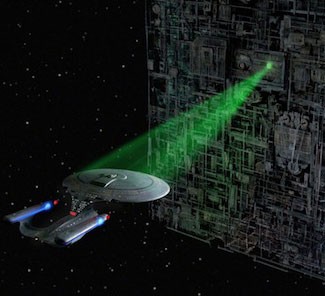Scientists Build Reversible Laser Tractor Beam
| Dino Lirios | | Oct 20, 2014 05:44 AM EDT |
(Photo : Ededu.net) A tractor beam as portrayed in the famous science fiction show, Star Trek
Laser physicists from Australia have just built a reversible "tractor beam" capable of moving tiny particles.
This tractor beam--the world's first-ever--has moved particles one fifth of a millimeter in diameter to a distance of 20 centimeters. It's a long way off from the tractor beams in science fiction shows like Star Trek or Star Wars, but it's a good start.
Like Us on Facebook
Wieslaw Krolikowski of Australian National University (ANU) said this feat is about 100 times further than previous experiments.
These experiments conducted at the University of Saint Andres relied heavily upon the motion of photons to propel particles on a microscopic level.
The ANU experiments, on the other hand, used the laser a little bit differently. Rather than working on photon momentum, scientists used heat instead.
A laser beam is hollow. It's bright around the edges and dark within its center. It can repel and attract objects.
The energy from the laser hits the particles and travels across its surface. It's then absorbed, creating hotspots on the surface.
Air particles that collide with the hot spots heat up and shoot away from the surface, causing the particles to recoil in the opposite direction.
To move and steer the particle, the team controls the polarization of the laser beam to heat up the desired portion of the particle's surface.
"We have devised a technique that can create unusual states of polarization in the doughnut shaped laser beam, such as star-shaped (axial) or ring polarized (azimuthal)," said Dr. Cyril Hnatovsky of ANU.
This allows scientists to move smoothly from one polarization to another, thereby stopping the particle or reversing its direction.
This technology is versatile and could be used to help control atmospheric pollution. It can also be used to retrieve tiny, delicate, and dangerous particles for sampling.
TagsTractor beam, Star Trek, Star Wars, Australian National University, Cyril Hnatovsky
©2015 Chinatopix All rights reserved. Do not reproduce without permission
EDITOR'S PICKS
-

Did the Trump administration just announce plans for a trade war with ‘hostile’ China and Russia?
-

US Senate passes Taiwan travel bill slammed by China
-

As Yan Sihong’s family grieves, here are other Chinese students who went missing abroad. Some have never been found
-

Beijing blasts Western critics who ‘smear China’ with the term sharp power
-

China Envoy Seeks to Defuse Tensions With U.S. as a Trade War Brews
-

Singapore's Deputy PM Provides Bitcoin Vote of Confidence Amid China's Blanket Bans
-

China warns investors over risks in overseas virtual currency trading
-

Chinese government most trustworthy: survey
-

Kashima Antlers On Course For Back-To-Back Titles
MOST POPULAR
LATEST NEWS
Zhou Yongkang: China's Former Security Chief Sentenced to Life in Prison

China's former Chief of the Ministry of Public Security, Zhou Yongkang, has been given a life sentence after he was found guilty of abusing his office, bribery and deliberately ... Full Article
TRENDING STORY

China Pork Prices Expected to Stabilize As The Supplies Recover

Elephone P9000 Smartphone is now on Sale on Amazon India

There's a Big Chance Cliffhangers Won't Still Be Resolved When Grey's Anatomy Season 13 Returns

Supreme Court Ruled on Samsung vs Apple Dispute for Patent Infringement

Microsoft Surface Pro 5 Rumors and Release Date: What is the Latest?










